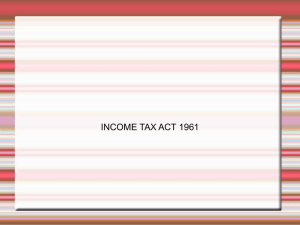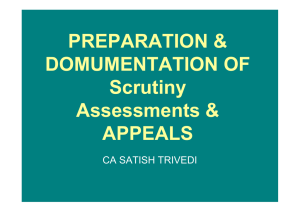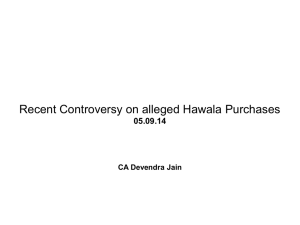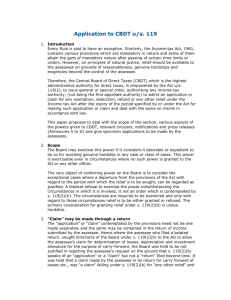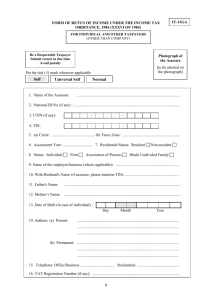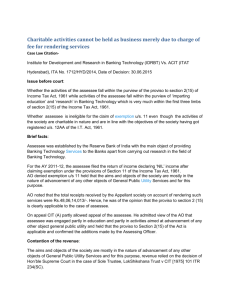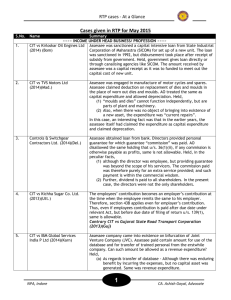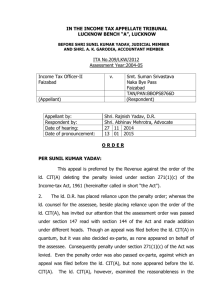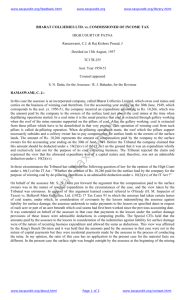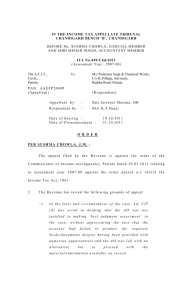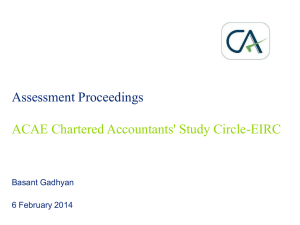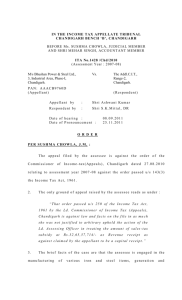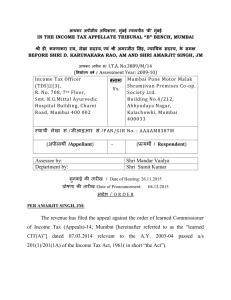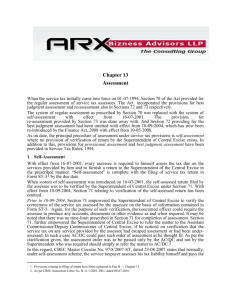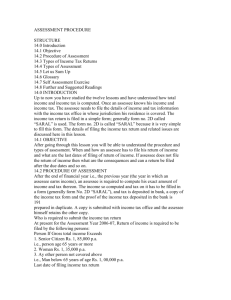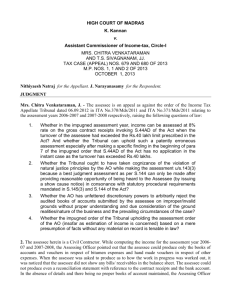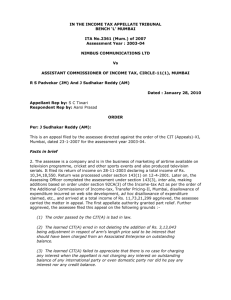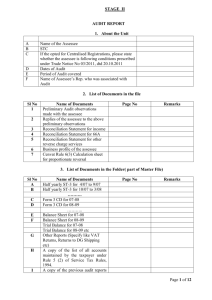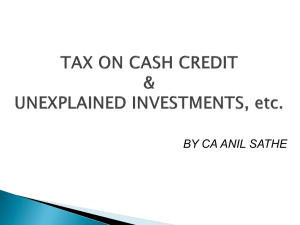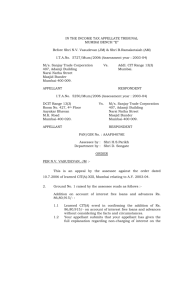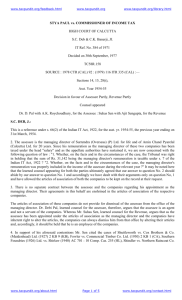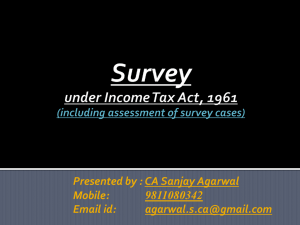Preparation-Documentation-for-scruting-assessment-appeals
advertisement
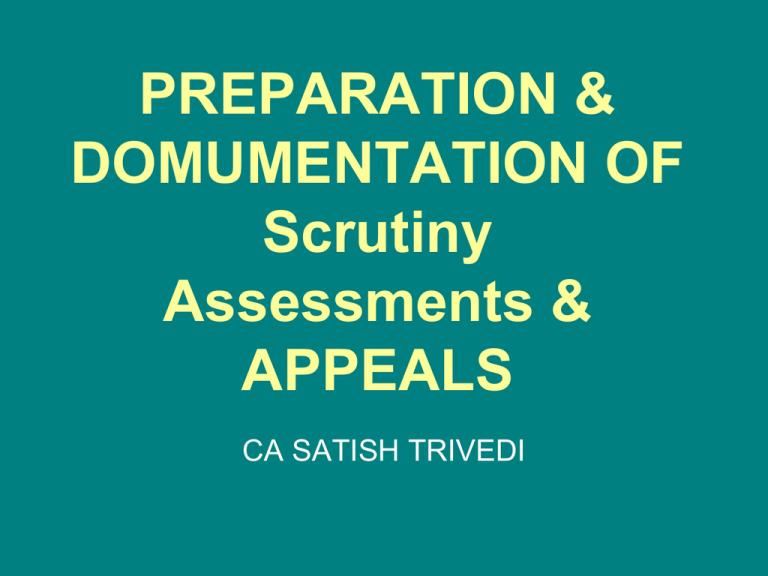
PREPARATION & DOMUMENTATION OF Scrutiny Assessments & APPEALS CA SATISH TRIVEDI Definitions • As per section 2(8) of the Income-tax Act 1961 the “assessment” defined as “assessment includes re-assessment” – The assessment u/s 143(3)/144 means after taking into account such particulars as the assessee may produce, the assessing office shall by an order in writing determine the total income or loss, allow or reject any claim of the assessee and to collect tax or allow him to carry forward the loss or refund the excess tax paid and other proceedings under the Income Tax Act 1961. Process of Assessment • • • • • • • Pre-requisites for selection Selection and Notice Enquiry before Assessment Assessment Order and Demand/Refund Rectification Application Filing of Appeal PROCEDURE & CRITERIA FOR SELECTION OF SCRUTINY CASES MANUAL SELECTION FOR F.Y.2013-14: 1.Cases where value of international transaction u/s 92b exceeds Rs.15/crores. 2.Cases involving addition in earlier year on the issue of TP in excess of Rs.10/crores. 3.Cases involving addition in earlier asst. year in excess of Rs.10/- lacks on recurring question of law. Selection for Scrutiny (Contd..) 4. Survey u/s 133A 5. Search and seizure u/s 153A, 153C r.w.s.143(3). 6. All returns filed in response to notice u/s 147/148 of the Act. 7. Cases claiming exemption u/s 11 or u/s 10(23C) hit by prov. To sec.2(15) of the Act. 8. Entities which recd. Donation from abroad in excess of Rs.1/ crore. Selection for Scrutiny (Contd..) • During F.Y.2011-12(A.Y.:-2012-13) under the prov. Of FCRA 9.Cases in respect of which information is received from other Government Department or other authorities pointing out tax evasion, like Receipt of Share premium, information of Bogus sales/purchase bills. 10.CASS Notice • • • • • Under Section 143(2) Under Section 142(1) Under Section 148 Summons u/s131 Enquiry u/s 133(6) Notice u/s 143(2)(ii) • • • • A return u/s 139 or in response to a notice u/s142 (1). AO considers it necessary or expedient to determine that the assessee has not understated the income or not computed excessive loss or not under paid the tax. Can be issued to attend, or to produce or cause to be produced, any evidence. On or before after the expiry of six months from the end of the financial year in which the return is furnished. Case-laws on Notice u/s 143(2) • The time limit for issue of notice u./s. 143[2] should be within 12 months from the end of the month in which a return is furnished beyond this notice void ab-initio: Dy. CIT vs Mahi valley Hotels and resorts [2006] 287 ITR 360 [Gujarat ] • Delhi High Court CIT vs Born Textiles P Ltd [2006] 287 ITR 370 [Delhi] held that even where notice were issued before the due date if it has not been served in due date the assessment in pursuance thereof would be invalid . Enquiry Before Assessment • 142 (1) empowers AO to make enquiries before assessment. • Can ask for filing of return if not filed u/s 139. • Can ask to produce accounts/ documents/ information. • The AO cannot ask for accounts relating to a period of more than 3 years prior to the previous year. Preparation for Scrutiny • Preparation should start from the finalization stage itself. • Copy of Final Accounts/Tax Audit Report. • Nature of Business. • Secured Loans • Unsecured Loans. • Details of Major expenses. • Stock register • Statutory payments u/s 43B Preparation for Scrutiny • Liabilities • Share Application Money/Capital introduced. • Additions to Fixed Assets. • Financial expenses. • Expenses covered u/s 36 & 37 • Claims u/s 35 • Chapter VIA deduction • Expenses not deductable u/s 40 Preparation for Scrutiny • • • • • • • Investments made and source thereof. Disallowance u/s 14A of the Act. Exempt income. Depreciation. Other income. Any probable AIR information. Letter of Authority Documentation • Prepare a Data Sheet/ Record Sheet upon receipt of Notice. • Keep record of all attendances, replies, visits, requirements and even phone calls. • All communications in WRITING. • Even if oral, should be followed by written confirmation. Documentation • First Attendance • Receipt of questionnaire • Procedure for Adjournment Documentation • Acknowledgement of submissions. • All information in one submission. • Indexing. • Page Numbers & Filing. Documentation • Covering Letter. • Reference about previous hearing. • Letter-head and Signature • Explain the constraints if any. Verification • Rule 14 • “I declare that to the best of my knowledge and belief, the information furnished in the statement/statements is correct and complete and other particulars shown therein are truly stated.” Options before the AO • • • • • • • • Enquiries u/s 133(6) Audit u/s 142(2A). Best Judgment Assessment (S. 144) Reference to Joint Commissioner u/s 144A. Reference u/s 144A can also be made by Assessee. Valuation u/s 142A. Summons u/s 131 Initiation of penalty proceedings. Why Reference by Assessee u/s 144A? Because AO has: • Not given proper justice to the submissions made by the assessee, • Not understood the nature of transaction and therefore misinterpreted it and added it to the assessee’s income, • Not understood the exact nature of business of the assessee, • Acted beyond his authority, Why 144A? • Not given proper time to the assessee for proving his case, • Misinterpreted the facts brought before him by the assessee, • Not called for information independently, which he could have otherwise collected easily, for want of proper justice, • Not allowed the opportunity of crossexamination Why 144A? • Not given the assessee the opportunity of natural justice, • Not given the assessee the opportunity of being heard, • Decided the case only with oral directions of his higher authorities without giving thought to the interpretations made by such authorities, whether the same are correct or otherwise. • Decided the case on the basis of some irrelevant papers, proofs, records, etc. not related to the case. Protective Assessment • Where there is a doubt or ambiguity about the real entity in whose hands a particular income is to be assessed, the assessing authority is entitled to take recourse to make a protective assessment in the case of one and regular assessment in the case of other. Additions • • • • • • • Show cause notice. Agreed Additions. Additions on Estimated Basis. Conditional Offer. Disallowance on technical grounds. Disallowance of Deductions/Exemptions. Ex-party order. What CBDT Says • • • • • • Postponement of hearing by AO. Different Timings for Different Assessee. Information to be requisitioned in advance. Affidavits should not be called. Over Assessment to be avoided. Law of natural justice to follow. Assessment Order • Section under which the assessee is being assessed, • Assessment year for which he is being assessed, • Dates of hearing, • Date of filing return by the assessee, • Amount of income at which he has assessed him, • Amount of income declared by the assessee in his return of income, Assessment Order • Why the AO is making addition, if any? • Details of records verified by him during the course of assessment, • Date of passing assessment order, • Demand, if any, arising after the assessment proceedings. Proper credit of the taxes paid. • • • • • • • CASE LAWS DWARKADAS KESARDEO MORARKA vs. COMMISSIONER OF INCOME TAX SUPREME COURT OF INDIA Conclusion of the Tribunal that investment of assessee in shares was a capital investment and not its stock-in-trade being based on inferences of fact raised from materials before taxing authorities and amply supported by evidence was on a question of fact and no question of law arose. COMMISSIONER OF INCOME TAX vs. THANTHI TRUST HIGH COURT OF MADRAS The principle laid down in H.A. Shah & Co. vs. CIT (supra) can apply, in our view, only to a case where there is a possibility of two different practices, both of which are consistent with law and the tax authorities accepting one practice and later insisting on a different practice which is likely to cause hardship and injustice to the assessee, and that principle will not apply to a case where the practice adopted earlier is not consistent with law. CASE LAWS CONT. • • • INCOME TAX OFFICER vs. M. PIRAI CHOODI SUPREME COURT OF INDIA Instead of setting aside the assessment order, the High Court should have directed the AO to grant an opportunity to the assessee to cross-examine the concerned witness; further, assessee having failed to avail the statutory remedy of appeal, High Court should not have quashed the assessment proceedings, under Art. 226 of the Constitution; assessee given liberty to move CIT(A). • DHAKESWARI COTTON MILLS LTD. vs. COMMISSIONER OF INCOME TAX SUPREME COURT OF INDIA Assessment—Validity—ITO is not bound by technical rules of evidence but assessment without reference to any material is not permissible—Matter remanded for reconsideration and to make assessment after proper opportunity to the assessee • • • Rectification u/s 154 • • • • • Mistakes apparent from the records. Arithmetical / Calculation Mistakes. Mistakes in Interest levied. Credit for Adv. Tax, SAT, TDS, TCS. Deductions etc. REVISION OF ORDER PREJUDICIAL TO REVENUE • Sec.263 The CIT may call for and examine the records of any proceedings under the Act, and if considers that any order passed by the AO is erroneous in so far as it is prejudicial to the interest of the revenue, he may after giving the “a” an opportunity of hearing, pass an order of enhancement, modification, cancellation and reassessment. APPEAL • Sec.246(1) Subject to the prov. of subsec.2 any “a” aggrieved by order of the A.O. may appeal to the CIT(A) against such order. • Form no:-35 • Grounds of Appeal. • Statement of facts. • Appeal fees. • Stay of demand. • Keeping penalty proceedings in abeyance. Thank You for Being a patient Audience. CA Satish Trivedi cajaintrivedi@gmail.com
